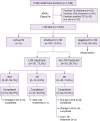1. Lee JE, Kim YK, Kim TH, Kim KH, Lee EJ, Uh ST, Choi TY. What strategy can be applied to the patients with culture positive tuberculosis to reduce treatment delay in a private tertiary healthcare center? Infect Chemother. 2011; 43:42–47.

2. Park HY, Jeon K, Suh GY, Kwon OJ, Chung DR, Yoonchang SW, Kang ES, Koh WJ. Interferon-γ release assay for tuberculosis screening of healthcare workers at a Korean tertiary hospital. Scand J Infect Dis. 2010; 42:943–945.

3. Lee K, Han MK, Choi HR, Choi CM, Oh YM, Lee SD, Kim WS, Kim DS, Woo JH, Shim TS. Annual incidence of latent tuberculosis infection among newly employed nurses at a tertiary care university hospital. Infect Control Hosp Epidemiol. 2009; 30:1218–1222.

4. Park SY, Lee EJ, Kim YK, Lee SY, Kim GE, Jeong YS, Kim JH, Kim TH. Aggressive contact investigation of in-hospital exposure to active pulmonary tuberculosis. J Korean Med Sci. 2019; 34:e58.

5. Jensen PA, Lambert LA, Iademarco MF, Ridzon R; CDC. Guidelines for preventing the transmission of Mycobacterium tuberculosis in health-care settings, 2005. MMWR Recomm Rep. 2005; 54:1–141.
7. Jo KW, Hong Y, Park JS, Bae IG, Eom JS, Lee SR, Cho OH, Choo EJ, Heo JY, Woo JH, Shim TS. Prevalence of latent tuberculosis infection among health care workers in South Korea: a multicenter study. Tuberc Respir Dis (Seoul). 2013; 75:18–24.

8. Yeon JH, Seong H, Hur H, Park Y, Kim YA, Park YS, Han CH, Lee SM, Seo JH, Kang JG. Prevalence and risk factors of latent tuberculosis among Korean healthcare workers using whole-blood interferon-γ release assay. Sci Rep. 2018; 8:10113.

9. Cho KS. Tuberculosis control in the Republic of Korea. Epidemiol Health. 2018; 40:e2018036.

10. Centers for Disease Control and Prevention (CDC). Recommendations for use of an isoniazid-rifapentine regimen with direct observation to treat latent Mycobacterium tuberculosis infection. MMRW Morb Mortal Wkly Rep. 2011; 60:1650–1653.
11. Arquello Perez E, Seo SK, Schneider WJ, Eisenstein C, Brown AE. Management of latent tuberculosis infection among healthcare workers: 10-year experience at a single center. Clin Infect Dis. 2017; 65:2105–2111.

12. Lee H, Koo GW, Min JH, Park TS, Park DW, Moon JY, Kim SH, Kim TH, Yoon HJ, Sohn JW. Factors associated with non-initiation of latent tuberculosis treatment among healthcare workers with a positive interferon-gamma releasing assay. Sci Rep. 2019; 9:61.

13. Khanna P, Nikolayevskyy V, Warburton F, Dobson E, Drobniewski F. Rate of latent tuberculosis infection detected by occupational health screening of nurses new to a London teaching hospital. Infect Control Hosp Epidemiol. 2009; 30:581–584.

15. Saukkonen JJ, Cohn DL, Jasmer RM, Schenker S, Jereb JA, Nolan CM, Peloquin CA, Gordin FM, Nunes D, Strader DB, Bernardo J, Venkataramanan R, Sterling TR. ATS (American Thoracic Society) Hepatotoxicity of Antituberculosis Therapy Subcommittee. An official ATS statement: hepatotoxicity of antituberculosis therapy. Am J Respir Crit Care Med. 2006; 174:935–952.

16. Schein YL, Madebo T, Andersen HE, Arnesen TM, Dyrhol-Riise AM, Tveiten H, White RA, Winje BA. Treatment completion for latent tuberculosis infection in Norway: a prospective cohort study. BMC Infect Dis. 2018; 18:587.

17. Sterling TR, Villarino ME, Borisov AS, Shang N, Gordin F, Bliven-Sizemore E, Hackman J, Hamilton CD, Menzies D, Kerrigan A, Weis SE, Weiner M, Wing D, Conde MB, Bozeman L, Horsburgh CR Jr, Chaisson RE. TB Trials Consortium PREVENT TB Study Team. Three months of rifapentine and isoniazid for latent tuberculosis infection. N Engl J Med. 2011; 365:2155–2166.

18. Belknap R, Holland D, Fenq PJ, Milet JP, Caylà JA, Martinson NA, Wright A, Chen MP, Moro RN, Scott NA, Arevalo B, Miró JM, Villarino ME, Weiner M, Borisov AS. TB Trials Consortium iAdhere Study Team. Self-administered versus directly observed once-weekly isoniazid and rifapentine treatment of latent tuberculosis infection: a randomized trial. Ann Intern Med. 2017; 167:689–697.

19. Getahun H, Matteelli A, Chaisson RE, Raviglione M. Latent Mycobacterium tuberculosis infection. N Engl J Med. 2015; 372:2127–2135.
20. Fountain FF, Tolley E, Chrisman CR, Self TH. Isoniazid hepatotoxicity associated with treatment of latent tuberculosis infection: a 7-year evaluation from a public health tuberculosis clinic. Chest. 2005; 128:116–123.

21. Park SJ, Jo KW, Yoo B, Lee CK, Kim YG, Yang SK, Byeon JS, Kim KJ, Ye BD, Park SH, Shim TS. Comparison of LTBI treatment regimens for patients receiving anti-tumor necrosis factor therapy. Int J Tuberc Lung Dis. 2015; 19:342–348.

22. Njie GJ, Morris SB, Woodruff RY, Moro RN, Vernon AA, Borisov AS. Isoniazid-rifapentine for latent tuberculosis infection: a systematic review and meta-analysis. Am J Prev Med. 2018; 55:244–252.

23. Menzies D, Adjobimey M, Ruslami R, Trajman A, Sow O, Kim H, Obeng Baah J, Marks GB, Long R, Hoeppner V, Elwood K, Al-Jahdali H, Gninafon M, Apriani L, Koesoemadinata RC, Kritski A, Rolla V, Bah B, Camara A, Boakye I, Cook VJ, Goldberg H, Valiquette C, Hornby K, Dion MJ, Li PZ, Hill PC, Schwartzman K, Benedetti A. Four months of rifampin or nine months of isoniazid for latent tuberculosis in adults. N Engl J Med. 2018; 379:440–453.










 PDF
PDF ePub
ePub Citation
Citation Print
Print



 XML Download
XML Download